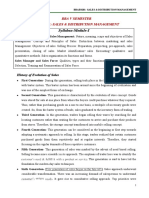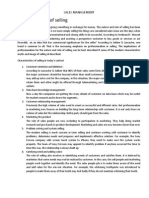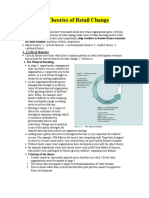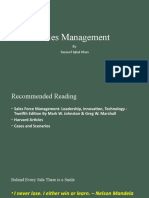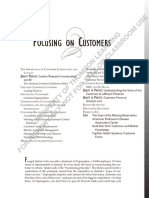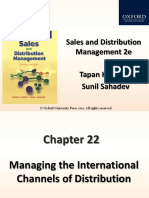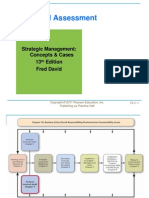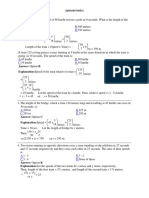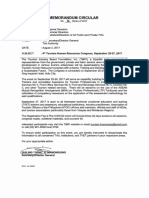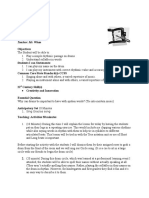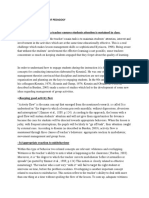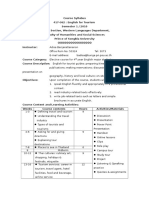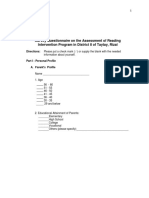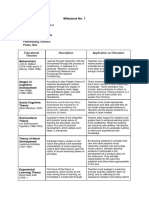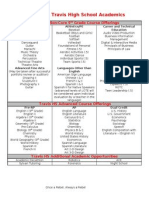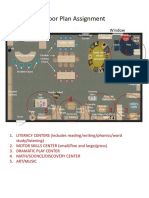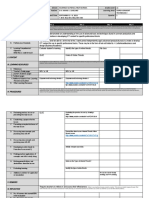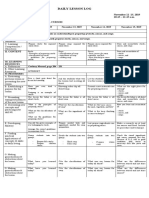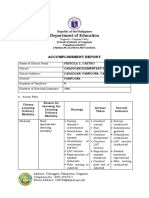Unit-10 Training The Sales Force PDF
Uploaded by
bhar4tpUnit-10 Training The Sales Force PDF
Uploaded by
bhar4tpManaging the Sales Force:
UNIT 10
Objectives
TRAINING THE SALES FORCE
After reading this unit, you should be able to: understand the importance of training for the sales personnel learn the training process identify the areas in which training for the field sales personnel can be of use understand how to conduct each step of training. Structure 10.1 10.1 10.2 10.3 10.4 10.5 Introduction Logic of Training Training Process Areas of Sales Training Process of Identifying Training Needs Methods of Identifying Training Needs 10.6.1 Self Observation 1 0.6.1 Reports 10.6.2 Survey of Questionnaires 10.6.3 Face-to-Face Interviews 10.6 .4 Focus Group Learning Styles Designing and Conducting the Programme 10.8.I Self Learning Modules 10.8.2 Class Room Training and Refresher Courses 10.8.3 On the Job Training Trainer's Abilities 10.9.1 Analytical Abilities 10.9.2 Educational Abilities 10.9.3 Training Techniques 10.9.4 Ensuring Participants' Participation 10.9.5 Course Organisation Training Follow-Up Summary Key Words Self-Assessment Questions Further Readings
10.7 10.8
10.9
10.10 10.11 10.12 10.13 10.14
10.1 INTRODUCTION
If you ask any sales person or a sales manager about how did they learn the selling skills, majority of them will answer, 'by experience'. The statement, however is really useful when we learn the correct things by experience and more importantly when we are able to use the lessons successfully. But what happens when we make mistakes? Next time we don't do the same mistake and we say, " I learned it all the hard way." It is suggested that, as training manager, you should be sure to check what he learnt the hard way. There are salesmen who have never learnt the art of closing their sales. There are others who have talked too much for all the years they were in selling. In fact, there are still many more, who, never discovered the best way to sell or manage their time. Experience alone is perhaps never sufficient. We all have to learn from the knowledge and experience of the others. This is where the right training can make a difference. Training can help transform a below-average salesman to an average salesman, or the average salesman to sell higher and the top salesman to reach newer heights. In a competitive market, sales training can bridge the gap between success and failure. Customers generally evaluate a company's product based on the salesman's performance, confidence or lack of confidence, inability to fully explain the product benefits, etc. When the market is competitive the customer may place the order with salesman who performs better than the other in a sales interview.
20
10.2 LOGIC OF TRAINING
It must be clearly understand that a training programme is just a small portion of the total learning experience of any participant. Before any participant attends a training programme, the trainer must identify specific area of knowledge, skills, or attitude in the participant that needs to be improved. (A detailed account on these points is given in 10.5). After the training programme, it is expected that the participants have gained the required knowledge, skills or attitudinal change. Before the Training Training After the Training Total Value of Training
Training the Sales Forces
However, the more important part is when the participant uses this new knowledge, skills and attitude at his work place to get better results, than he was getting prior to training. These results will benefit the organization and will add more value to the organization. Thus to consider the total value of any training, it is important to consider the sequence of training activity in its totality, i.e., before the training, the training event and after the training.
10.3 TRAINING PROCESS
Training can be defined as learning to change the performance of people, doing certain tasks. From this definition we observe that training revolves around helping people to learn so as to improve their performance. The training process can be broken down into four major steps, for easy understanding. These steps are, identifying training need ,designing the programme, conducting the programme, training follow up. Apart from the above distinctive steps, a trainer must have knowledge about adult learning styles, so that the programme can be tailored as per requirements. Diagrammatically, the training process can be represented in the following manner:
21
Managing the Sales Force:
10.4 AREAS OF SALES T NING
The purpose of a sales training programme is to impart training in the following broad areas mentioned below: Company's knowledge - nature of industry to which the organisation is related. The organisational place in its industry and industrial practices Product knowledge and applications Sales techniques - the selling process, negotiation skills, sales presentation, handling complaints, post sales follow-ups, etc. Reporting systems
Depending upon the contents of training programme the training methods or technique are selected. These methods are discussed under item 9.8, in this unit.
10.5 PROCESS OF IDENTIFYING T IMNG NEEDS
A training need can be defined as a gap between the desired level and the actual level of knowledge, skills or performance that can be. bridged by training. The starting point for organising and conducting an effective training programme for the salesmen is the careful and precise identification of training needs. Well intentioned, but general sales training may not yield good results. To the salesmen it may not appear to be tailored to their needs, or it failed to take account of the special selling situations they generally face. Thus it is very important to perceive and identify the individual's training needs and then decide about the objectives and contents of the training programme. The identification the sales training needs is a rational undertaking and it has to be done in proper sequence, which are as follows: The first step in the identification of the training needs is to define the jobs, to be done, the specific tasks involved and the performance standards required .This involves writing of the jobs description. Secondly, specifying what knowledge, skills and attitudes are needed to achieve the standards set for the job. Based on the job description, a training needs analysis can be done setting out the knowledge, skills and attitudes, Some examples of such an exercise are given below : JOB DESCRIPTION/TASK/KNOWLEDGE SKILLS/ATTITUDES ANALYSIS
22
Training the Sales Forces
23
Managing the Sales Force:
24
Training the Sales Forces
25
Managing the Sales Force:
Thirdly, define what knowledge, skills and attitudes each salesman has, how and what performance standards each is achieving. The collection of this information requires the setting up and constant use of an effective salesman performance appraisal system. It also involves agreement on measurement standards and techniques.Fourthly identifying the training gaps in each areas of knowledge, skills and attitudes. Fifthly, define what additional training needs arise as a result of changes external to the salesman's past achievements and standards. This necessitates checking on a systematic and continuous basis the directions and future plans for the company's marketing planning, sales planning and recruitment functions. For example; a decision to add a couple of products to the existing product line could involve every salesman in revising his method of working, route planning and scheduling, thus giving rise to a new training need in the field. It is therefore, necessary to relate the company's future plans to its current sales force needs. Lastly, define the training priorities for the current period, i.e., to identify what are the training needs in the immediate future, in the mid-term and in the long term, and accordingly prioritise the training activity. Activity 1 Suppose your are the sales manager for a Kashmir carpet manufacturer. You have a vacancy in your sales force in the Maharastra region. You want to recruit only that person who is fully familiar to the product. What type of training objectives you would have, if you wish to prepare your sales personnel fully for the field job? ......................................................................................................................................... ......................................................................................................................................... .......................................................................................................................................
10.6 METHODS OF IDENTIFYING TRAINING NEED
For the success of any training it is of utmost importance that the training needs are identified, objectively and correctly. Training need analysis will help in identifying employees who need training and also you can set specific criteria's to measure the results of training. Some of the methods used for identifying training needs are :
26
10.6.1 Self Observation Observations can work only when a salesman is observed doing his job, continuously for a specific period, by an observer. Advantages : Observation gives you an idea about the actual working of a salesman. It is a low cost technique with minimum disruption to the work. Also, in this technique you yourself observe the salesman and thus the bias is avoided , in the observations. Disadvantages : The major disadvantage of this technique is that the salesperson may not act normally when someone is with him as lat feeis scrutinized. Also you may not observe all the attributes due to infrequency of occurrence of some attributes. Another disadvantage of this technique is that sometimes it is difficult to record the observation data. 10.6.2 Reports Any organization will have number of reports that record different aspects of job performance regularly, like, work records, sales output, sales trend, etc. A careful study of these reports can help in identifying training needs. Advantages : You have a long track record of performance which can be used. The salesman is not aware that you are watching him. In this method, you do not incur any additional cost. Disadvantages : As the quantum of information available through the sales reports is large, his method is time consuming. 10.6.3 Surveys and Questionnaires These are the written forms that are completed and returned either by the Salesperson himself or by his manager, after filling them up. Advantages : These forms bring out opinions and facts about a current situation by questioning the people involved. These are useful in getting information from a large or geographically dispersed people. The respondents can complete them at their convenience, without any distraction. Disadvantages : If the questions are not framed in a simple language, the respondents may not understand the questions. Secondly, only those people who are interested, will generally send their reply to a survey. 10.6.4 Face to Face Interviews A face to face interview is the process of meeting a salesperson individually to discuss issues that concerns him the most. Advantages : These interviews are helpful when you are dealing with sensitive issues that require explanatory answers. Another advantage of this process is that you can clarify things by asking questions and also you can observe the non-verbal clues. Disadvantages : The salesperson may not like such interviews where you are making notes. Face to face interview is also a time consuming process. 10.6.5 Focus Groups In a focus group, 10-15 salespersons meet to discuss a topic and exchange views, attitudes to give suggestions. Such discussions are useful when handling an undefined issue. Advantages : Focus groups offer valuable but general data. With the help of focus group discussions you can identify questions and issues that can be used to conduct specific surveys.
Training the Sales Forces
27
Managing the Sales Force:
Disadvantages : A focus group has to be followed by other hypes of surveys for getting specific information. A focus group is time consuming and in such studies it is difficult to quantify results. As you must have observed, you can use any or all of the above methods for identifying training needs. Once the data is collected, you need to analyze data for prioritizing different needs that may emerge. One important point that should be kept in mind is that during these surveys certain needs can emerge that cannot be handled by training. These may include pay increases, incentives, work conditions, etc. Therefore, the suggestion is that when you are analyzing data you must focus only on those needs that can be addressed by training.
10.7 LEARNING STYLES
When you are designing a training programme, you must keep in mind that different people, learn easily from different learning styles. Therefore, you should be able to identify the best learning style. Broadly speaking any person has one of the following as dominant learning style: Activist, Reflector, Theorist or Pragmatist. You must appreciate the fact that these are the learning styles and need not reflect the personality of any individual. Activist :An activist involves himself fully and without bias in new experiences. He is open minded, riot skeptical and is enthusiastic about anything new. He is happy to take problems by brainstorming. Thus, if you are designing a programme for an activist, be sure to include situations of his participation's like, games, simulation exercises, etc. Reflector: He likes to stand back to ponder experiences and observe them from varied perspectives. He will collect data, himself and from others, and prefer to think it thoroughly before coming to any conclusion. He prefers to take a back seat in meetings and discussions and enjoys observing other people in action. He tends to adopt a low profile. While designing a programme for a reflector, be sure to include actual case studies and experiences and guide him to make his own decisions. Theorist : He integrates observations into complex but logically sound theories. He thinks problems through in a step by step way. He likes to analyze and synthesize. He tends to be detached, analytical and dedicated to rational objectives. rather than anything subjective or ambiguous. His approach to problems is consistently logical. Pragmatists : He is keen on trying out ideas, theories and techniques to see if they work in practice. He is the sort of person who will return from training brimming with new ideas that he wants to try out in practice.
10.8 DESIGNING AND CONDUCTING THE PROGRAMME
For training of sales force, you can use one of the three major types of programmes. These methods are self study modules, class-room training, on the job training. However for all the programmes, the planning must be done comprehensively to ensure effectiveness of the training. 10.8.1 Self Learning Modules In this programme, the participants are given the course material which they are required to study themselves. Written totes can be sent, and if needed audio and video cassettes can be used. This kind of training is useful when you want the participants' to revise some material or you want to send some pre-conference study material. The major disadvantage of this method is that you cannot be sure whether the participants have actually studied the material. Also, in this method, there is no feedback. 10.8.2 Class Room raining Each training programme needs to be individually planned based on the pre-decided objectives decided for the programme. However the following are t he important areas that can be covered in a typical sales related programme :
28
Company knowledge - history and future plans Product information Marketing strategies for various products Learning the features, advantages, benefits of products How to obtain interview with prospective customers The sales presentation Different ways of finding customer's needs Answering objections Closing the sales presentation Planning geographical territory and planning each day Time management Administrative responsibilities Communication abilities Writing reports
Training the Sales Forces
The objective of a class room based refresher course is to reinforce some aspects in the salesmen which they are likely to forget and also to add new knowledge and skills to the salesmen. Thus, as the name suggests a refresher and development course must refresh the memory and develop the true potential of the salesmen. To truly meet its objective, a refresher course must be based on factual information. Thus complete information on salesmen's behaviour, weaknesses and general morale must be available before designing any refresher course. The information can either be obtained through a questionnaire sent to participants or through personal interviews, or any other methods, as discussed under 9.6.Soine of the questions that need to be answered for running an effective refresher course are: Planning Does a salesman prepare and work his plan Does he keep up to date records Does he call regularly on his customers Is his appearance professional Does he keep his presentation material neat and clean Does he have a positive or a negative attitude How is his response to official communication How much is he influenced by outside influences How good is his product knowledge How updated are his selling skills Does he have knowledge of any special techniques
Appearance
Attitude
Selling Skills
Once all the information is gathered, the trainer can plan different session of refresher course which can include case studies, role plays, syndicate presentations, simulations etc. 10.8.3 On The Job Training One of the very important ways of teaching new skills to sales people is through on the job field training. The important advantage of this method offers is that the skills are demonstrated to the salesmen in the real life situation and thus the impact on the salesmen is expected to be much stronger. Also the individual salesman's needs can be identified and attended to. In on-the-job or field training, the trainer can either make a sales call himself which the salesman observes and learns. In the other method of on-the-job training the trainer gives feedback to the salesman after observing him during his sales call. The salesman, thereafter, practices the recommendations in the future calls.
29
Managing the Sales Force:
Activity 2 To better identify the training needs of your sales personnel, you circulated a questionnaire., An analysis of the questionnaires revealed that your sales personnel need to learn handling of difficult customer or complaining customers. What type of training method you would use, and why? ......................................................................................................................................... ......................................................................................................................................... .........................................................................................................................................
10.9 TRAINER'S ABI1 TIES
A successful trainer needs to posses various skills to do a good job of training. Some of the basic things without which a trainer cannot be successful are, thorough job knowledge and an ability to relate to the actual situations the salesman experiences. The other main abilities which a trainer must posses are : 10.9.1 Analytical ability A good trainer is able to analyze the situations and identify the exact training needs for salespersons. The analytical ability will help the trainer to focus on issues of prime importance rather than touching superficial issues. 10.9.2 Basic Educational Abilities A trainer needs to have the knowledge about the jobs the salespersons perform. He should also know the principles of communication. It would be still better if the trainer has some knowledge about the adult learning. 10.9.3 Training Techniques A successful trainer needs to understand what makes people learn and accept new things. He should have clear knowledge about the different techniques of training. He should be able to employ such techniques, for maximum results. 10.9.4 Ensuring Participants' Participation To ensure effective learning, the training session must be interactive where participants freely participate. Some of the methods employed for ensuring trainee participation are: Discussion Groups: Trainees are divided into groups and given various topics, issues etc. which they have to discuss amongst themselves and come up with probable solutions. Questions and answers period, after each session. Decision making exercises, e.g. finding product benefits and converting them into sales presentations for various types of customers. Demonstrations : These can be either trainees acting out certain role plays or video demonstrations or demonstrations by the trainer. Case studies: Participate attempt to find the best possible solution for a real life problem.
10.9.5 Course Organization Once the total written material for a course is ready, the session can be put into practice. A good trainer will always keep in mind some basic rules of organizing a training session, like : Punctuality is essential. All material related to training like, slides, demonstration pieces, samples, etc. , must be carefully checked before the programme. The room where the: training is to be held must be checked for adequate lighting and seating arrangements.
30
10.10 TRANING FOLLOW UP
Training follow up refers to the time immediately following the training. This may vary from, the time when learners are still a captive audience, to possibly months or years after the training. What happens after training is vital to any training session. After any training session you must gather and analyze feedback to review training. Measure and analyze results specially in relation to job performance. Provide additional inputs, if these has been a shortfall, of similar training programmes are organised in future.
Training the Sales Forces
10.11 SUMMARY
In order to meet the sales and marketing objectives successfully, it is necessary for each organisation to train their sales personnel, as objectively as possible. The training activities should be tailored to the specific needs of the sales personnel and the typical market situations they face. Therefore, it becomes mandatory to identify the training needs. Once the training needs have been identified, then commences the process of executing the training programme. Activities, such as identification of teaching material , appropriate trainer and training methods, all should be decided, as carefully as possible. Lastly, one should learn from one's experience and therefore, evaluation and review of a training programme is also an important and integral component of any training activity.
10.12 KEY WO S
Training: Training can be defined as learning to change the performance of people doing certain tasks. Training revolves around helping people to learn so as to improve their performance. Training Needs: A training need can be defined as a gap between the desired level and the actual level of knowledge, skills or performance that can be bridged by training. Self Learner Module: The participants are given the course material which they are required to study themselves. Written notes can be sent, and if needed audio and video cassettes can also be used. On Job Training or Field Training: In on the job or field training the trainer can make a sales call himself which the salesman observes and learns. In the other method, the trainer gives feedback to the salesman after observing him during his sales call. The salesman, in the future calls thereafter, practices the recommendations.
10.13 SELF-ASSESSMENT QUESTIONS
1. 2. 3. 4. How an applicant, before accepting a job, could appraise himself quality of training that will be provided to him? Why is sales training a continual managerial activity? Why is product knowledge also considered to be a sales related training need? Why do sales trainers rely so much on role-play in teaching sales techniques. Discuss its advantages over other training methods?
10.14 FURTHER READINGS
The following units of the Management Programme are recommended for further readings. MS-2, Unit 6. MS-22, Block -1. MS-23,Unit - 12.
31
You might also like
- Chap 8 Tanner - Recruitment and SelectionNo ratings yetChap 8 Tanner - Recruitment and Selection23 pages
- Coaching Skills for Sales Managers: Making the Great Stride from Manager to an Effective CoachFrom EverandCoaching Skills for Sales Managers: Making the Great Stride from Manager to an Effective CoachNo ratings yet
- Unit 39 Sales Management Assignment BriefNo ratings yetUnit 39 Sales Management Assignment Brief4 pages
- Sales and Distribution Full Class Notes Detailed Version, GLA UniversityNo ratings yetSales and Distribution Full Class Notes Detailed Version, GLA University28 pages
- Marketing Management: 14 Developing Pricing Strategies and ProgramsNo ratings yetMarketing Management: 14 Developing Pricing Strategies and Programs39 pages
- Strategic Customer Management: Systems, Ethics, and Social ResponsibilityNo ratings yetStrategic Customer Management: Systems, Ethics, and Social Responsibility28 pages
- Chapter 10 Evaluating Sales Force PerformanceNo ratings yetChapter 10 Evaluating Sales Force Performance34 pages
- Developing, Delivering & Reinforcing A Sales Training ProgramNo ratings yetDeveloping, Delivering & Reinforcing A Sales Training Program12 pages
- Unit No.1 404 MKT Sales and Distribution Management 2017 PDF100% (1)Unit No.1 404 MKT Sales and Distribution Management 2017 PDF113 pages
- The Impact of Your Sales Training Program: How To MeasureNo ratings yetThe Impact of Your Sales Training Program: How To Measure4 pages
- Sales and Distribution Management 2e Tapan K. Panda Sunil SahadevNo ratings yetSales and Distribution Management 2e Tapan K. Panda Sunil Sahadev11 pages
- A.introductintrodution of Marketing Marketing Planning 1No ratings yetA.introductintrodution of Marketing Marketing Planning 135 pages
- Selling Process & Selling Skills - Group 6No ratings yetSelling Process & Selling Skills - Group 610 pages
- Controlling Sales Force Report PPT Ronak TejaniNo ratings yetControlling Sales Force Report PPT Ronak Tejani29 pages
- Introduction To Sales and Distribution Management: SDM-Ch.1 1No ratings yetIntroduction To Sales and Distribution Management: SDM-Ch.1 122 pages
- Time: 3 Hours Total Marks: 70: Printed Pages:02 Sub Code: RMBMK01 Paper Id: 270306 Roll NoNo ratings yetTime: 3 Hours Total Marks: 70: Printed Pages:02 Sub Code: RMBMK01 Paper Id: 270306 Roll No2 pages
- Impact Negotiations Toolkit: 50+ powerful tools to negotiate a better job, life, community, and worldFrom EverandImpact Negotiations Toolkit: 50+ powerful tools to negotiate a better job, life, community, and world5/5 (1)
- Unit-1 Product Management - Basic ConceptsNo ratings yetUnit-1 Product Management - Basic Concepts9 pages
- Effects of Global Warming: Greenhouse Gases A Scientific Consensus That Climate Change Is Occurring Glacier RetreatNo ratings yetEffects of Global Warming: Greenhouse Gases A Scientific Consensus That Climate Change Is Occurring Glacier Retreat4 pages
- Bem 1202:fundamentals of Pedagogy Cat1: - B) Appropriate Reaction To MisbehaviourNo ratings yetBem 1202:fundamentals of Pedagogy Cat1: - B) Appropriate Reaction To Misbehaviour7 pages
- FS 4 Exploring The Curriculum Full EpisoNo ratings yetFS 4 Exploring The Curriculum Full Episo15 pages
- Survey Questionnaire On The Assessment of Reading Intervention Program in District II of Taytay, RizalNo ratings yetSurvey Questionnaire On The Assessment of Reading Intervention Program in District II of Taytay, Rizal4 pages
- Tomas Del Rosario College: City of BalangaNo ratings yetTomas Del Rosario College: City of Balanga2 pages
- 2012-2013 Travis High School Academics: Travis HS Non-Core 9 Grade Course OfferingsNo ratings yet2012-2013 Travis High School Academics: Travis HS Non-Core 9 Grade Course Offerings3 pages
- Effectiveness of Enhanced Learning Materials in Science For The Open High School ProgramNo ratings yetEffectiveness of Enhanced Learning Materials in Science For The Open High School Program15 pages
- Department of Education: Republic of The PhilippinesNo ratings yetDepartment of Education: Republic of The Philippines2 pages
- Accomplishment Report-Pilot Testing-CabagganesNo ratings yetAccomplishment Report-Pilot Testing-Cabagganes10 pages
- Factors Affecting The Failing Grades of Bcu Humss 11 A StudentsNo ratings yetFactors Affecting The Failing Grades of Bcu Humss 11 A Students28 pages
- Psychological Testing: Chapter 4 - Employee Selection 2No ratings yetPsychological Testing: Chapter 4 - Employee Selection 265 pages









